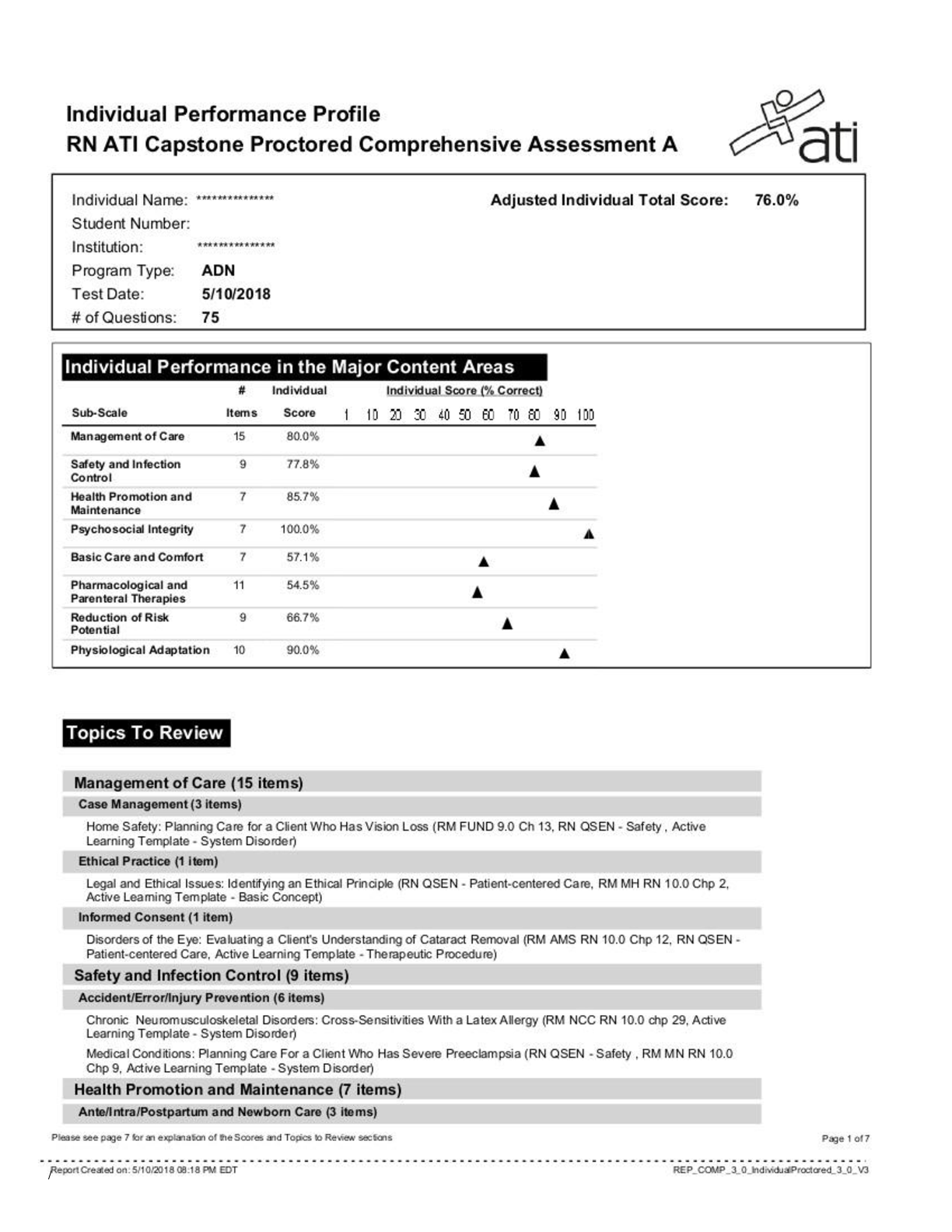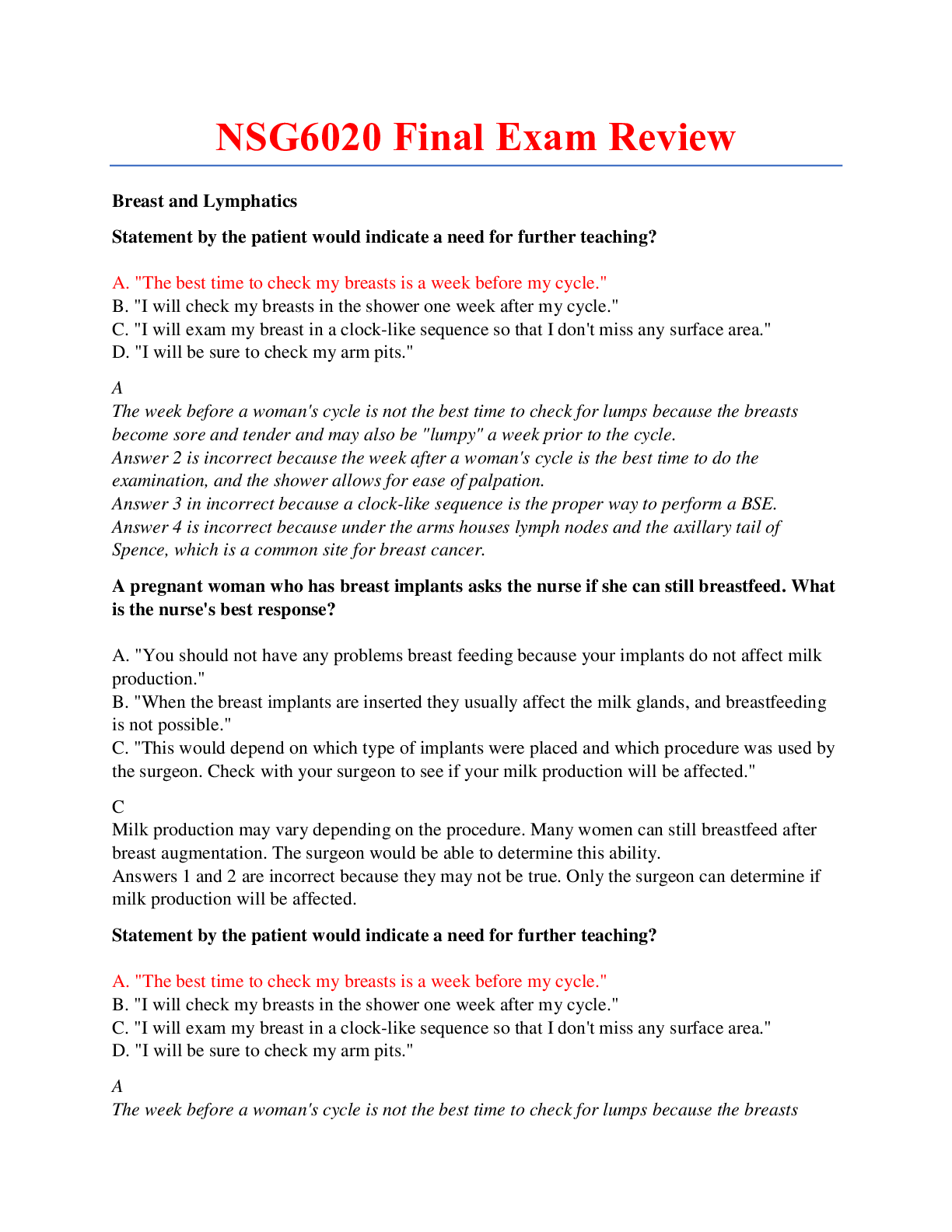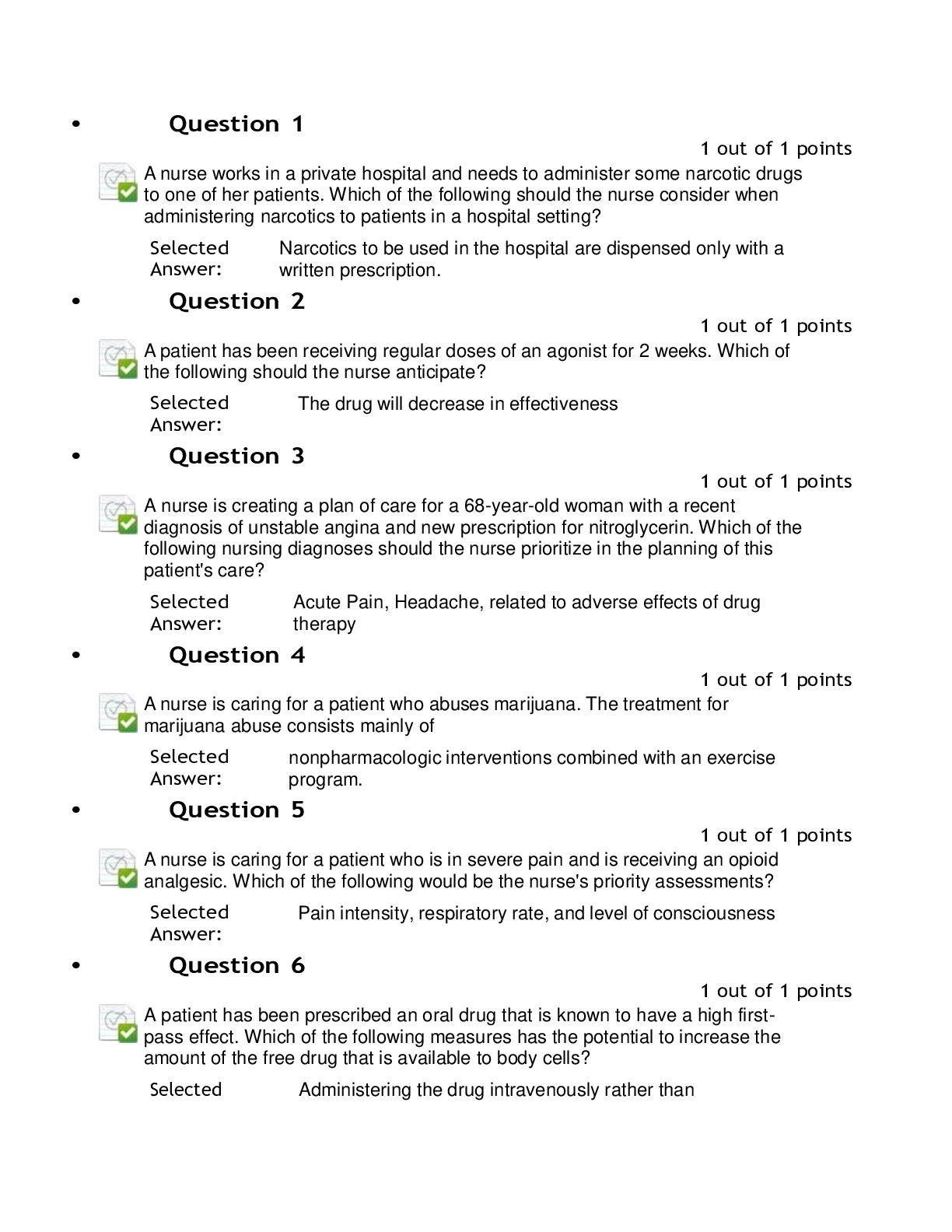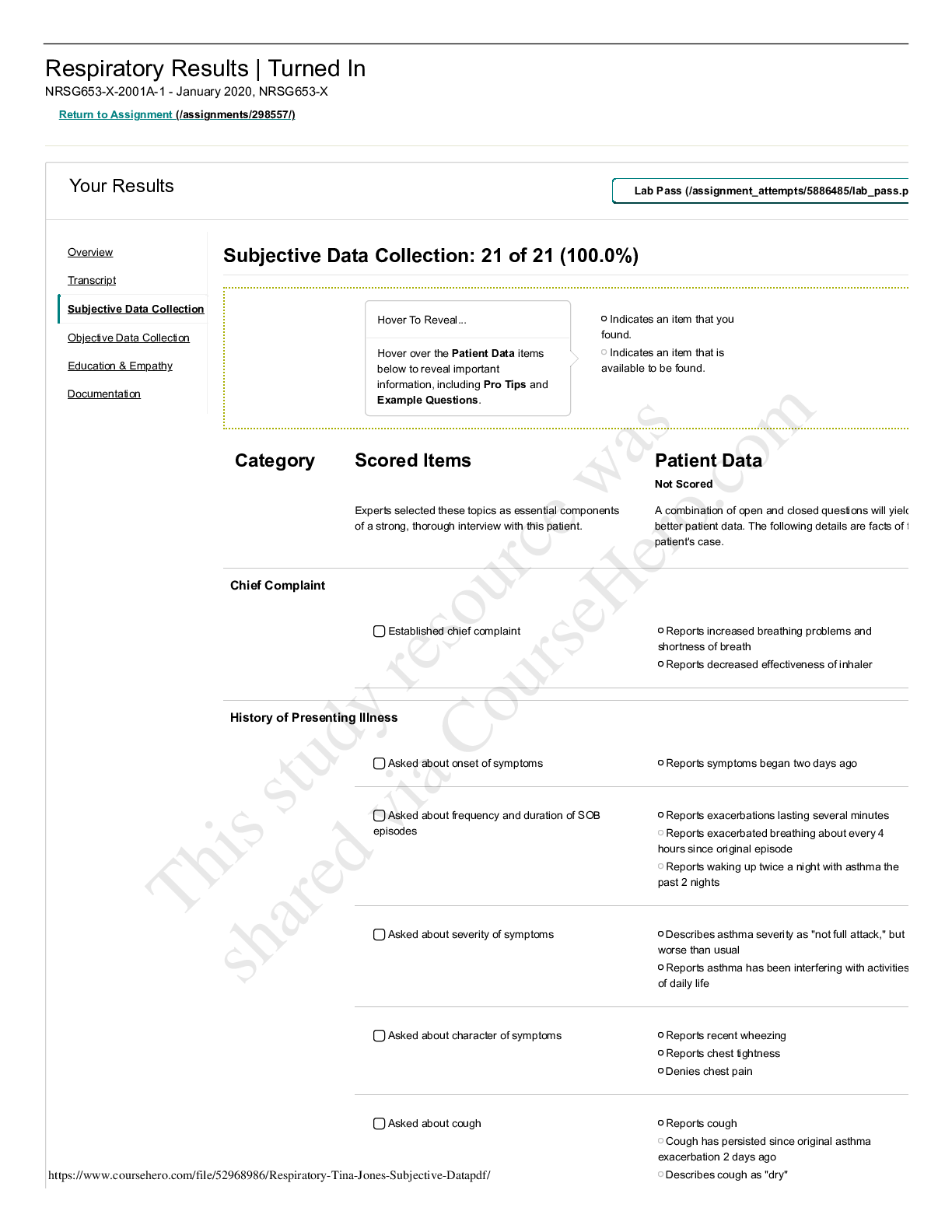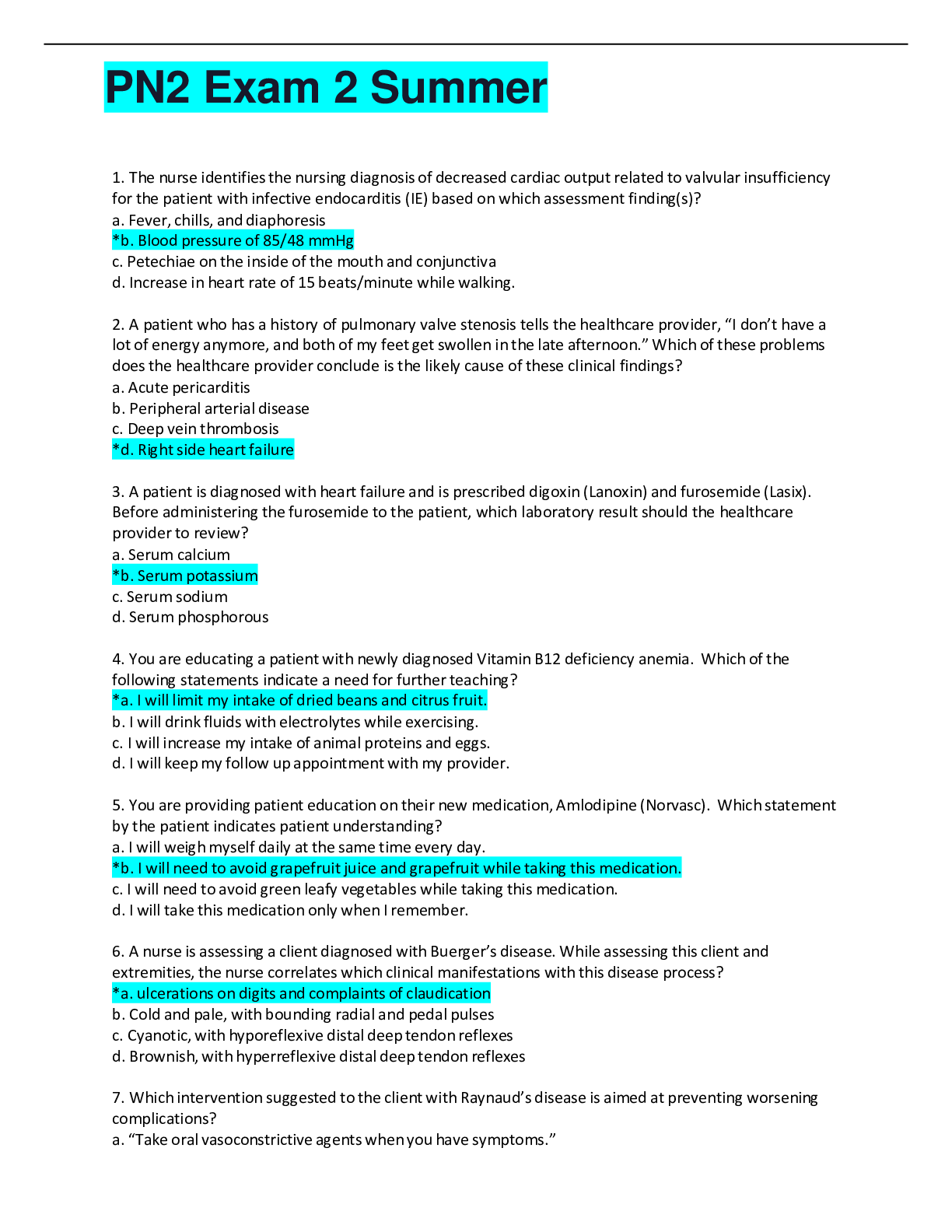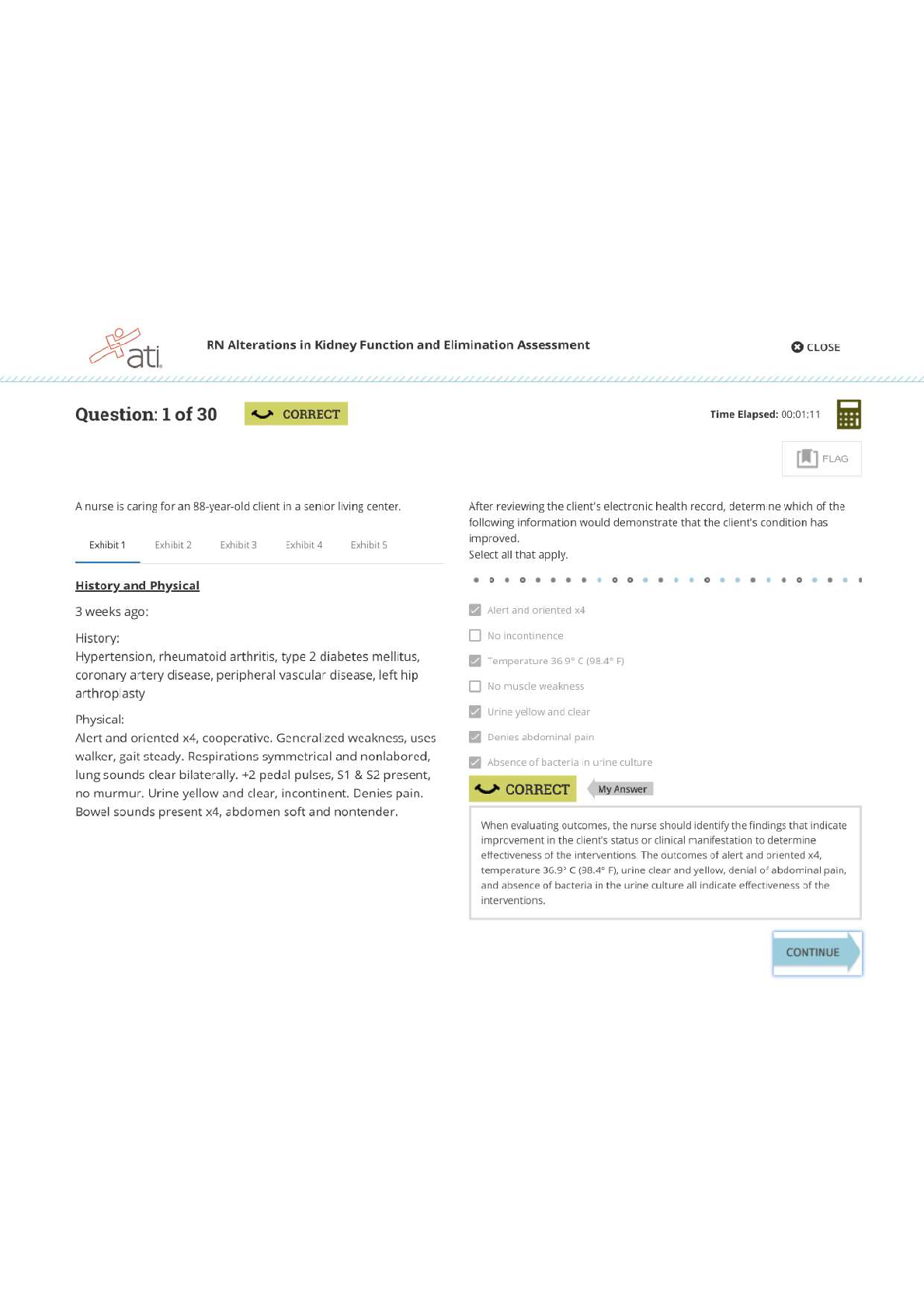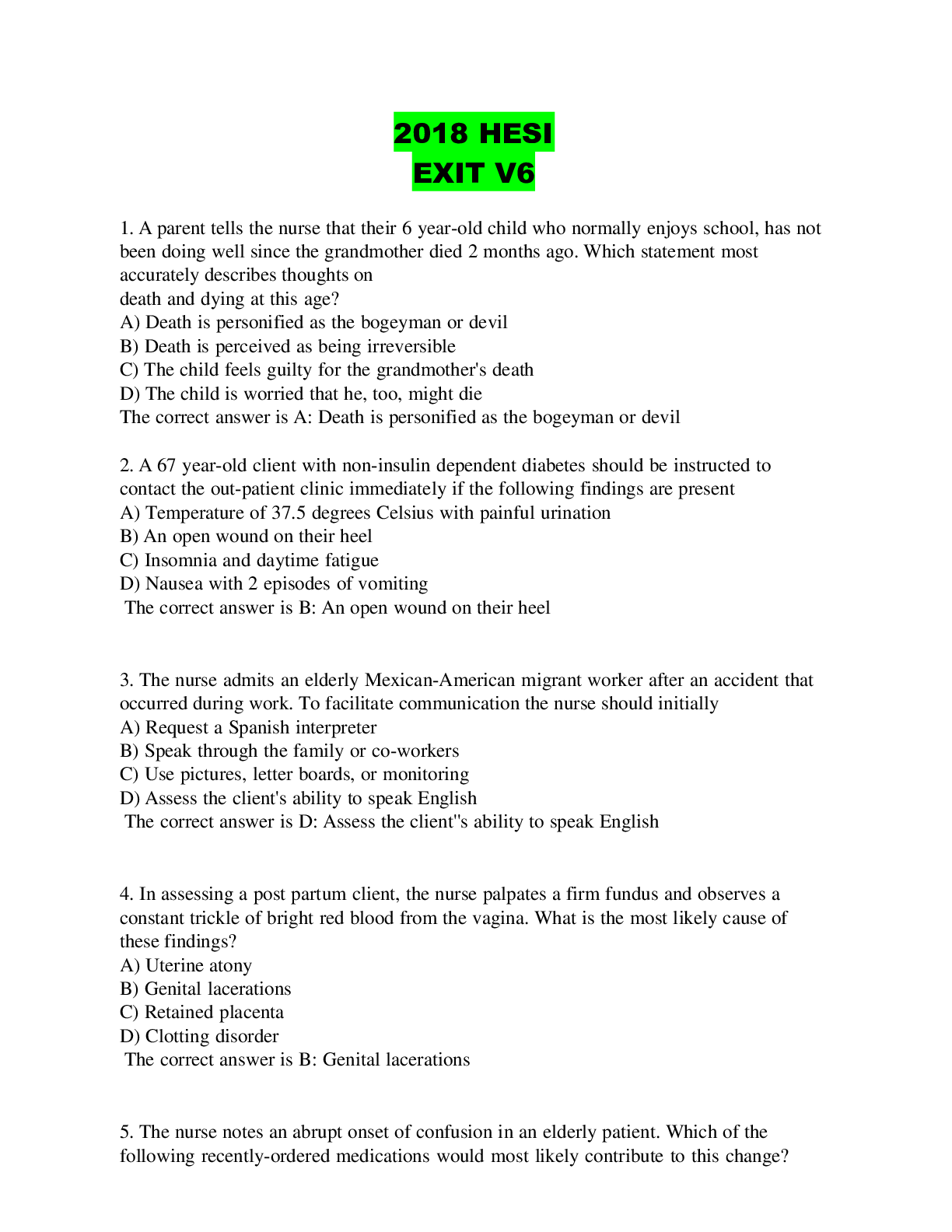NUTRITION 10 Grade Boost. Graded A
Document Content and Description Below
NUTRITION 10 Grade Boost **CHAPTER ONE QUIZ** 1) Most of the enzymes responsible for the digestion of the energy nutrients come from the: a. Mouth b. Stomach7 c. Liver d. Pancreas 2) W... hat is the approximate average body water content of a young adult human expressed as a percent of body weight? a. 10-20% b. 30-40% c. 50-60% d. 70-80% e. 90% 3) List the six classes of nutrients, give a good source example and note which ones provide energy. a. Proteins – salmon b. Carbohydrates – bread c. Fats – butter d. Minerals – whole grain, meats e. Vitamins – spinach f. Water – watermelon (PROTEINS, CARBOHYDRATES, AND FATS PROVIDE ENERGY) 4) What are the three basic functions of nutrients a. Energy b. Structure c. Regulation 5) Most of the body’s water occurs in extracellular fluid compartments (outside of the body cells). a. True b. False 6) Define an essential nutrient. a. An essential nutrient is nutrients that the body cannot make or cannot make at a rate sufficient to meet needs. 7) Define the Recommended Dietary Allowance (RDA) and list three factors that are taken into consideration when establishing the RDA. a. the daily amount of nutrient considered adequate to meet the needs of nearly all healthy people. i. Age groups ii. Gender iii. Physiological states 8) Define digestion and describe the two types of digestion. a. Digestion – process of which food is broken down into a form that can be absorbed by the intestines. i. Physical digestion – moving and grinding of food (mouth esophagus stomach) ii. Chemical digestion – enzyme breakdown (stomach pancreas small intestine) 9) What is absorption and where does it occur? a. Absorption – process of moving nutrients into body or bloodstream. b. Absorption occurs in the surface of the small intestine. **CHAPTER TWO QUIZ** List a good food source for each: a. A complete protein: breast milk, egg whites b. A protein with a low chemical score: white flour c. A protein with a high PER: fish d. An incomplete protein: rice 1) Which of the following has the highest relative protein requirement expressed in grams of good protein per kg body weight per day? a. 2 – year old child b. an adult mad c. a teenager d. all have the same protein requiremento 2) A 60kg female eats 1 cup of vegetarian chili that provides 15 grams of protein. a. What is the percent of DV for protein from the 1 cup of the chili? i. 15g/ 50g x 100 = 30% b. What is the percent of RDA for protein from the 1 cup of the chili for the 60kg female? i. 60kg x 0.8 grams/kg per day = 48grams protein/day ii. 15g/48g x 100 = 31.25% 3) Would you expect the amino acid profile (the amount of amino acid) to be the same from protein in beef, almonds, refried beans, and a human blood cell? Why or why not? a. No, because food proteins (like body proteins) differ in their amino acid content. Food sources differ in the quality of protein present. Each amino acid has a different R group so the structures are different. 4) Protein quality is primarily determined by the amount of each of the 20 amino acids. a. True b. False 5) Which of the following food proteins have a limiting amino acid? a. Peanut butter b. Refriend beans c. Wheat bread d. Tofu e. A through C above 6) The Recommended Dietary Allowance (RDA) for protein represents the average amount of “perfect” protein needed by most of the healthy population. a. True b. False **CHAPTER THREE QUIZ** 1) When looking at a Nutrition Facts food label, the energy value of a food is expressed in ________ and represents the ______ present in food. a. Milligrams / total potential energy b. Calories / total potential energy c. Calories / physiologically available energy d. Milligrams / physiologically available energy 2) Males always have a greater basal metabolic rate than females (expressed in kcal/day). a. True b. False 3) Determine the calorie content of 2 tablespoons of peanut butter (SHOW YOUR WORK). a. Fat 16g b. Carbohydrate 16g c. Protein 18g d. Fiber 2g i. Calculate the percent of calories coming from fat, protein, and carbohydrates ii. Fat 16g x 9kcal/g = 144 kcal iii. Carbohydrate 16g x 4kcal/g = 64 kcal iv. Protein 18g x 4kcal/g = 72kcal v. Total = 280 kcal 1. 64kcal/280kcal x 100 = 22.86% kcal from carbs 2. 72 kcal/ 280kcal x 100 = 25.71% kcal from protein 3. 144 kcal/ 280kcal x 100 = 51.43% kcal from fat 4) Calculate the total energy intake for the following person (SHOW YOUR WORK). a. Female; 68 kg; light activity; losing 1lb every 2 weeks i. BMR: 0.9 kcal/kg x hour x 68kg x 24 hours/day = 1468.8 kcal/day ii. Activity: +50% BMR 0.5 (1468.8 kcal/day) = 734.4 kcal iii. Loss: 3500 kcal/ 1 lb x 1 lb/ 2 weeks x 1 week/ 7 days = 3500 kcal/14 days = -250 calories per day iv. TEF: 5% (BMR + Activity – Loss) 0.05 (1468.8 kcal + 734.4 kcal – 250 kcal) = 97.66 kcal/day v. Total energy intake: BMR + Activity – Loss + TEF) (1468.8 kcal + 734.4 kcal – 250 kcal + 97.66 kcal) = 2050.86 kcal/day 5) List and define the three compounds of your energy requirements. List approximate values for each component. a. Basal Metabolic Rate (BMR) the amount of heat/energy/calories needed to keep basic body functions going btw 1,000 – 2,000 kcal daily b. Activity energy needed to perform any activity above the BMR usually equal or less thank your BMR c. Thermic Effect of Food (TEF) amount of energy needed to digest & assimilate food fall between 50 to 200 kcal 6) Describe three factors that affect your BMR. a. Age older you get, BMR drops b/c loss of muscle mass b. Fasting BMR drops 10-20% within 24 hours c. Exercise boosts your BMR 7) What is a calorie? a. The heat needed to raise 1 liter (about 4 cups) of water 1 degree Celsius; a measure of heat energy. **CHAPTER FOUR QUIZ** List good food sources of Insoluble fiber: wheat, grains, vegetables Glycogen: NO FOOD SOURCES/ Lactose: milk, yogurt, cheese Polysaccharide: potato, grain, vegetables, bread, pasta Disaccharide: cookies, candy, soda Simple sugar: sucrose, candy, soda, fruits Water-soluble fiber: fruits, beans (kidney, black, pinto, & others), oats 1) The major monosaccharide found in the body is: a. Glucose b. Fructose c. Galactose d. Sucrose e. Maltose 2) The storage form of carbohydrates in the body is: a. Glucose b. Cholesterol c. Glycogen d. Fat e. Glycoprotein 3) What is the percent Daily Value for fiber in 1 bean burrito with 8 grams of fiber? a. 8 grams/ 25 grams x 100 = 32% DV 4) Describe the two types of fiber, give their actions in the intestine, health benefits, and list a food source for each. a. Water-insoluble fiber: “water-holding” in intestinal tract & swells up. Speeds passage and “works-out” muscles of intestinal tract. i. Health benefits: low fiber hemorrhoids and diverticulitis; High fiber lower risk of developing hemorrhoids, diverticulitis, & colon cancer. ii. Food source: celery, vegetables b. Water-soluble fiber: comes in contact with water and other liquids forms a gel; intestinal tract gel property slows the emptying of your stomach i. Health benefits: reduce hunger, lower cholesterol, lowers heart disease, lower type two diabetes 5) What is lactose intolerance? a. People who lack the enzyme lactase or have very little and the inability to digest milk sugar. 6) Describe what happens when carbohydrate is eaten in excess of energy needs. a. When carbohydrate is eaten in excess of energy needs is converted to and stored as fat. Liver takes the C2 units and builds a fat. Fat is sent off for storage in fat cells. 7) How many calories are released during the aerobic energy metabolism of carbohydrate? a. 2 calories/g b. 4 calories/g c. 6 calories/g d. 9 calories/g 8) What is diabetes? a. Diabetes is the lack of insulin and some people do not make insulin. Must take a replacement of insulin via an injection and that puts insulin directly into the circulation. 9) How long do glycogen stores last for a person who is inactive but not eating? a. 1 hour b. 12 hours c. 24-36 hours **CHAPTER FIVE QUIZ** 1) List a good food source for each of the following. a. Monounsaturated fat: olive oil b. Polyunsaturated fat: corn oil c. Saturated fat: butter d. Cholesterol: beef e. Trans fat: margarine (hydrogenated veggie oil) f. LDL: NO FOOD SOURCE g. 18:2 (linoleic): soybean oil h. 18:3 (linolenic): flaxseed oil 2) Fat is transported through the circulation system to various to tissues, such as muscle and adipose, as: a. Small droplets made exclusively of triglyceride b. Lipoproteins, composed primarily of triglyceride, cholesterol, and protein c. Cholesterol droplets, which can accumulate on arterial walls to form fatty deposits d. Separate droplets containing either cholesterol, triglyceride, or phospholipids and coated with protein e. C and D above 3) Hydrogenation is a process that makes unsaturated fats: a. More solid b. Have a higher cholesterol content c. More resistant to oxidation d. A and B e. A and C 4) Bile is made from and functions in: a. Calcium/ fat digestion b. Cholesterol / fat digestion c. Prostaglandins / carbohydrate digestion d. Cholesterol / carbohydrate digestion e. Prostaglandins / fat digestion 5) If you eat more protein than you need at any given time, in an otherwise adequate diet, the excess amino acids are largely converted to: i. Energy nutrients in food ii. Basic units in body iii. Stored as iv. carbohydrate v. glucose vi. glycogen (muscle & liver) vii. fat viii. triglyceride, fatty acid ix. body fat stores (draw arrow that says excess from glucose to this) x. protein xi. amino acids xii. arrow going to body fat stores, another arrow for nitrogen in urine, and last arrow goes to protein replacement needs first b. Cholesterol c. Fatty acids d. Fructose e. Muscle protein f. Hormones 6) The end products of fat energy metabolism are: a. Fatty acids plus glycerol b. Monosaccharides c. CO2, H2O plus energy d. Same as carbohydrate energy metabolism (aerobic) e. C and D above 7) You’ve just finished stuffing yourself at an all-you-can-eat buffet. Describe energy metabolism following this large meal (use Figure 5.27). FOLLOWING A MEAL, ENERGY NUTRIENTS ARE PUT AWAY INTO STORAGE. 8) Describe energy metabolism during a 24- to -36 hour fast (use Figure 5.29). a. WITH FASTING, GLYCOGEN STORES IN BOTH THE LIVER AND MUSCLE HAVE RUN OUT. Energy source Basic unit in body Used for Body protein Amino acids Glucose, brain energy Arrow from amino acids to nitrogen in urine, and another arrow from amino acids to energy Fat stores Fatty acid Arrow to Energy (body use), and another arrow to ketones **CHAPTER SIX QUIZ** 1) List a good food source of a. Cholesterol: beef b. Polyunsaturated fat: safflower oil c. HDL: NO FOOD SOURCE d. Fat type that raises blood cholesterol levels: saturated fat (beef) 2) Which of the following statement (s) concerning dietary fats and cholesterol is/are true? a. Consumption of diets containing a high level of saturated fatty acids is associated with a high level of blood cholesterol. b. All food fats that contain a high proportion of saturated fatty acids (40 percent or more), either naturally occurring or produced by hydrogenation, are major sources of dietary cholesterol. c. Reducing the proportion of dietary energy (calories) provided as fat and reducing the saturated fatty acid content of the diet will tend to reduce the blood cholesterol level. d. A + C are true. e. All the above (a through c) are true. 3) Which lipoprotein is thought to protect against cardiovascular disease? a. Low Density Lipoprotein (LDL) b. Very Low Density Lipoproteins (VLDL) c. High Density Lipoproteins (HDL) d. Triglycerides (TG) 4) Your friend has asked you if his daily fat intake of 92 grams and saturated fat intake of 33 grams meet recommendations to reduce risk of heart disease. His daily intake is 2400 kcal. Is he following recommendations? (SHOW WORK). a. Recommendations: <35% of kcal as fat, <7% kcal saturated fat b. 2400 kcal x 0.35 = 840 kcal i. 840 kcal/ 9 kcal/gram = 93.3 grams of fat; not following recommendations c. 2400 kcal x 0.07 = 168 kcal i. 168 kcal/ 9 kcal/gram = 18.7 grams of saturated fat, not following recommendations 5) What specific recommendations would you give to someone interested in lowering his or her risk for cardiovascular disease? a. Total dietary intake of fat should be less than 25-35 percent of total calories b. Saturated fat intake should be less than 7 percent of total calories (trans fat included). c. Dietary cholesterol intake should be less than 300 milligrams per day. d. Meet the Daily Value for fiber of 25 grams per day. e. Sodium intake should be less than 1,500 milligrams of sodium f. Limit alcohol intake g. Achieve a healthy weight h. Physical activity – 30 minutes or more most days a week 6) What is metabolic syndrome? a. Three out of five of the following clinical measurements. Abdominal obesity: waist circumference for women >35 inches and men >40 inches, insulin resistance (blood glucose), hypertension (high blood pressure), low HDL levels, high fasting blood triglyceride levels. 7) A blood cholesterol level of 245 mg/dL is considered healthy. a. True b. False 8) A dietary intake of 245 mg/day for cholesterol is in keeping with recommendations. a. True b. False 9) Low HDL levels (<40 mg/dL) reflect a greater risk for heart disease. a. True (low levels high risk) b. false **CHAPTER SEVEN QUIZ** 1) What time period(s) during the life span of humans are fat cell numbers normally increasing? a. Third trimester of fetal development through the first year of life b. Adolescent growth spurt (12-14 years of age) c. 20-25 years of age d. A and C above 2) Body fat distribution as measured by _________ is used as an indicator of abdominal obesity and subsequent health risks. a. Height – to – weight ration b. Percent body fat c. Waist circumference d. Desirable body weight 3) With weight loss resulting in a decrease of body fat, fat cell size _______ and fat cell number ________. a. Increases / decreases b. Decreases / decreases c. Unchanged / decreases d. Decreases / unchanged 4) The Body Mass Index (BMI) can be used as an indicator of obesity. The BMI is: a. A ratio of body fat to age b. A ratio of weight to height (kg/m2) c. A ratio of waist to hip measurement d. A ratio of body fat to body weight e. None of the above 5) A sound weight loss program should include: a. Reduced energy diet b. Behavior modification c. Physical activity or exercise 6) Choose one of the components in question 5 and describe why this should be included in a weight loss program (include how this component contributes to weight loss and its benefits). a. Behavior modification changing current eating behavior leads to decreased calorie intake & the establishment of new eating behavior conducive to weight loss & maintenance changing eating behavior understanding response to environmental cues cognitive restructuring. 7) There are several theories for the cause of obesity. Describe how each of the following theories may lead to obesity in an individual. a. Inactivity: expending fewer calories due to a decline of physical activity while caloric intake stays constant results in excess calories converted to and stored as fat. b. Fat cell size (fat mass): fat cells prefer to be filled to a certain size (fat cells designed to serve as energy reserves and not shrink away to nothing), people with high adipose cell number is doomed to be obese. c. Genetic Predisposition: To put away fat more efficiently or to burn fewer calories (BMR or TEF) while not adjusting caloric intake results in excess calories that are converted and stored as fat. 8) What is bulimia? How does dieting (restrictive eating) contribute to the development of this condition? a. Bulimia is binge eating and purging, or other methods to rid the excess calories. Loss of potassium due to heavy vomiting, loss of fat-soluble vitamins when laxatives are abused, and erosion of teeth enamel due to acid in vomit. 9) List of internal factor and one external factor that influences food intake control. a. Internal: hunger b. External: time of day **CHAPTER EIGHT QUIZ** 1) List a good food source for each nutrient a. Sodium: table salt b. Calcium (nondairy): cooked broccoli, fortified orange juice c. Non-heme iron: leafy greens d. Zinc: oysters 2) Which of the following statements about iron is NOT true? a. The RDA for iron is lower for women that for men. b. Iron absorption increases in a deficiency state. c. Iron is absorbed more effectively from animal flesh. d. Vitamin C, ascorbic acid, taken at the same time as iron, will increase iron absorption. 3) Which of the following statements does NOT describe the role of minerals in the body? a. They are important for growth. b. They make possible the transfer of nerve impulses. c. They are constituents of important body compounds. d. They provide 4 kcalories per gram. e. They help maintain water balance. 4) Sodium and potassium work closely together to regulate fluid balance. a. True b. False 5) Trace minerals, such as iron and zinc, are necessary in small amounts, approximately 10 grams daily (less than one-third of an ounce). a. True b. False 6) What organ plays a role in the homeostasis of most minerals? a. Gall bladder b. Pancreas c. Liver d. Kidneys 7) Define minerals and describe their path through the food chain. a. Minerals are inorganic and are elemental substances other than carbon, hydrogen, oxygen, and nitrogen. b. Their path through the food chain are water/soil plants animals humans. 8) Define osteoporosis. List two factors that increase your risk and two factors that will decrease your risk for developing osteoporosis. a. Osteoporosis means “porous” bones and is characterized by weak bones with low mineral content. b. Two increasing risk factors: i. Inactive people ii. Smoking & heavy alcohol consumption. c. Two decreasing risk factors: i. Weight-bearing exercises ii. High intake of Vitamin D 9) Define bioavailability and list factors that affect bioavailability. a. The amount of proportion (percentage) of a nutrient & mineral that is available for absorption. b. Factors that affect bioavailability: i. Growth ii. Pregnancy iii. Fiber iv. Aging v. Medications vi. Components in food vii. Form of mineral in food **CHAPTER NINE QUIZ** 1) List a good food source for each vitamin a. Vitamin C (non-citrus): broccoli b. Niacin (B3): fish c. Beta-carotene: carrots d. Vitamin B6: whole grain breads e. Folate: citrus fruits f. Vitamin B12: eggs g. Vitamin E: Avocado h. Thiamin (B1): pork 2) During the milling process of grain products, such as wheat, portions of the kernel are removed, which decreases the content of: a. B vitamins only b. B vitamins and zinc only c. B vitamins, iron, zinc, and fiber d. Fiber and iron only 3) Therefore, grain products are enriched with a. B vitamins and fiber b. Vitamin B6, iron and fiber c. Thiamin, riboflavin, niacin, and folate d. Iron e. C and D above 4) Eating a diet deficient in water-soluble vitamins will result in clinical signs of vitamin deficiency in several weeks rather than years. a. True b. False 5) The effects of a deficiency of Vitamin D are most readily observed in the a. Muscular system b. Epithelial tissue c. Nervous system d. Digestive system e. Skeletal system 6) Which of the following micronutrients function as antioxidants protecting unsaturated fatty acids from oxidations? a. Zinc and fluoride b. Vitamin B6, vitamin B12, and folic acid c. Calcium, potassium, and vitamin C d. Vitamin C, vitamin E, and beta-carotene e. Vitamin D, vitamin K, and vitamin E 7) This vitamin is needed for cell replication and a deficiency causes anemia. Adequate intake of this vitamin during pregnancy may help prevent birth defects. a. Vitamin C b. Vitamin B12 c. Folate (folic acid) d. Niacin (B3) e. Thiamin 8) Define vitamins and describe their function (include both categories). a. Vitamins are organic substances and function in all body cells, but don’t work together as a “complex.” b. Water-soluble vitamins i. found in watery parts of cells ii. fast turnover iii. excess, from diet or supplement then filtered from blood into urine iv. functions as coenzymes c. fat-soluble vitamins i. not soluble in water, found in fatty parts of body and cells ii. turnover slow, need is less frequent iii. excess, from diet or supplement not excreted in urine iv. not coenzymes, function in more general roles 9) Describe three ways the vitamin categories differ. a. Water-soluble vitamins are found in watery parts of the cells and fat-soluble vitamins are NOT soluble in water. b. Water-soluble vitamins turnover fast and fat-soluble vitamins turnover is slow. c. Water-soluble vitamins acts as coenzymes and fat-soluble vitamins are not coenzymes. **CHAPTER TEN QUIZ** 1) Define a nutrient-dense food. a. Nutrient-dense food provide a good amount of one or more essential nutrients relative to one or more essential nutrients relative to the number of calories per serving. 2) List a food source for each of the following. a. Empty-calorie food: candy b. Nutrient-dense food: lean meats 3) The body’s alcohol processing enzymes are found in the: a. Stomach (only a small amount) b. Pancreas c. Liver (majority processes here) d. Small intestine 4) Food additives are a major cause of cancer, producing effects greater than those associated with foods, which increase or decrease risk. a. True b. False 5) List the four ways alcohol impacts nutritional status and provide a nutrient affect for each. a. Ingestion – protein, vitamins, and minerals b. Absorption – thiamin, folate, iron, and vitamin B12 c. Metabolism – vitamins D and A d. Excretion – minerals zinc, potassium, calcium, and magnesium, and folic acid 6) What are phytochemicals? How do they help protect you from cancer? a. Phytochemicals are protective factors in food. They help us protect against cancer by blocking tumor growth and others interfere with initiation phase. 7) Your friend is concerned about developing cancer and wants ways to lower their risk. Give five dietary recommendations to lower your friend’s risk for cancer. a. Maintain a healthy body weight/avoid weight gain with age b. Eat five or more servings of colorful fruits and vegetables daily c. Choose whole grains over refined grains d. Limit intake of salt-cured, smoked, and charbroiled foods and reduce red meat intake e. Consume alcoholic beverages in moderation **CHAPTER ELEVEN QUIZ** 1) During prolonged exercise body stores ________ are depleted. These stores can be increased through a high dietary intake of ______________. (Choose the best combination.) a. Protein/protein b. Glycogen / protein or carbohydrate c. Fat / carbohydrate d. Glycogen / fat e. Glycogen / carbohydrate 2) An athlete training daily and expending large amounts of energy should consume _________ grams of carbohydrate daily or approximately _____________ of total calories. (Choose best combination.) a. 100 grams / 40 percent b. 450 grams plus / 60 percent c. 200 grams / 45 percent d. 500 grams / <30 percent 3) Concerning fuel utilization, fats: a. Are the main fuel for muscles while at rest and during light activity b. Supply most of the energy for the brain c. Supply most of the energy for high-intensity exercise d. Provide more energy (calories) than an equal weight of carbohydrate e. Both A and D 4) List two nutrients required/ needed in greater amounts by athletes and why. a. Water i. Why? As sweat evaporates, the heat is “taken away.” It’s the medium that makes up the blood, which transports, oxygen, carbohydrates, and other nutrients to hard-working muscles. b. Sports drinks i. Why? Helps replenish lost fluids and provide carbohydrate to prolong endurance. They supply small amounts of minerals (electrolytes) that help replenish what’s lost in sweat and assist in maintaining fluid balance and muscle contraction and encourage further drinking. 5) What is dehydration and why are athletes at increased risk for developing dehydration? a. Dehydration is the loss of body fluids. Athletes are at increased risk for developing dehydration because of sweating due to heat accumulation in the body with declining cardiac function and increasing body temperature and performance is decreased. 6) Dietary supplements sold to enhance athletic performance are tightly regulated by the FDA. a. True b. False 7) Give an example of a pre-exercise meal. a. Eat two to four hours before you work out or compete (especially after a night’s sleep, your body needs fuel). **CHAPTER TWELVE QUIZ** 1) What are three rationales behind the Dietary Guidelines for Americans? a. Maintain a healthy weight b. Promotion of overall health c. Prevention of diet-related chronic diseases 2) What is a nutrient-dense food? Give five specific examples from each of the food groups. a. Nutrient-dense foods are foods that are not prepared with added solid fats, sugars, starches (refined grains), and sodium. i. Vegetables ii. Fruit iii. Whole grains iv. Lean meats and poultry v. Fat-free, low-fat, and milk products 3) The Dietary Guidelines for Americans recommend at least 30 minutes of physical activity a day for adults. a. True b. False 4) What is your estimated daily energy requirement? (Use Figure 12.2.) a. Sedentary 1800-2000 kcal/day 5) What is “SoFAS”? How do you plan to decrease your intake? (Be specific – give three ways.) a. “SoFAS” are solid fats and added sugars. We constitute about 800 calories daily or 35% of total calories daily. Should reduce intake of SoFAS to no more than 5-15% of total kcal. i. Limit intake of ice cream ii. Limit use of stick margarine iii. Completely cut-out sodas and sweeteners 6) How many servings are recommended from each of the five food groups to meet your calorie intake? a. Food groups Recommended # of servings daily b. Grains 8 grams of whole grains per ounce equivalent c. Vegetables 2 ½ cups d. Fruits 2 cups e. Milk 3 cups (fat-free or low-fat) f. Protein Foods (meat & beans) 8 ounces per week (average 250mg daily of omega-3 fats) Use the appropriate food tracking worksheet from the appendix (pp.478-482), fill in your food beverage choices fro yesterday. Then compare this to the five food groups and the recommended number of servings. Also, list the number of minutes you were physically active. How did you do? How would you change your food and beverage intake for tomorrow to meet the goal for your calorie intake? How about your physical activity level? How would you change this? I did so-so on the pyramid worksheet. I would try to balance out my meals so that I will consume adequate intake of food and beverage groups, to keep a healthy body and weight. My physical activity level would be increased to at least 60-90 minutes daily; meaning I would set aside time for this important activity. [Show More]
Last updated: 1 year ago
Preview 1 out of 21 pages

Reviews( 0 )
Document information
Connected school, study & course
About the document
Uploaded On
Aug 09, 2019
Number of pages
21
Written in
Additional information
This document has been written for:
Uploaded
Aug 09, 2019
Downloads
0
Views
79


